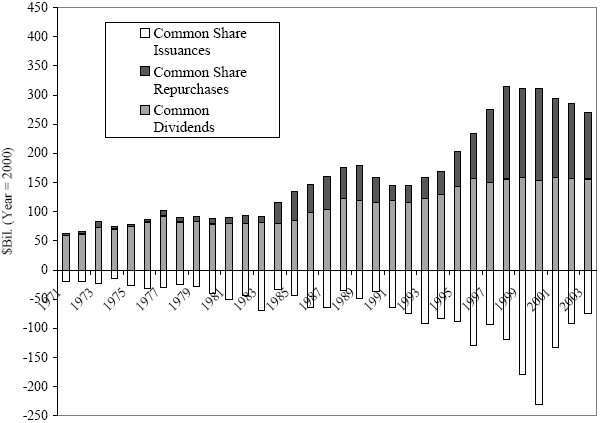Are company stock buybacks equivalent to cash dividends for stockholders? Conversely, are company sales of stock “undividends” for stockholders? A forthcoming article in the April 2007 Journal of Finance addresses these questions. In the underlying September 2005 paper entitled “On the Importance of Measuring Payout Yield: Implications for Empirical Asset Pricing”, Jacob Boudoukh, Roni Michaely, Matthew Richardson and Michael Roberts compare the predictive powers of several alternative measures of company payout encompassing dividends, stock repurchases and stock issuances. Using a maximum sample period of 1926-2003 (with stock repurchase data available only since 1971), they find that:
- In 1982, SEC rule 10b-18 diminished the predictive power of dividends for stock returns by facilitating stock repurchases/issuances as alternative ways for firms to distribute and receive cash from stockholders. The ratio of repurchases to total payouts (dividends plus repurchases) is just 5-15% through the early 1980s, after which it rises to nearly 50% in the 2000s. (See the chart below.)
- In contrast with dividend yield alone, total payout and net payout (dividends plus repurchases minus equity issuances) yields have statistically and economically significant predictive power for stock returns. For example, during 1926-2003, regression of annual stock returns on annual dividend yield produces an R-squared of 5.5%, while total and net payout yields produce R-squareds of 8.0-9.1% and 26%, respectively.
- The improvement in predictive power is consistent across the range of yields. For example, average monthly returns on low, medium and high dividend yield portfolios are 1.15%, 1.28% and 1.33%, respectively, while those for total (net) payout yield portfolios are 1.28% (1.24%), 1.40% (1.36%) and 1.56% (1.57%), respectively. Traditional risk factors do not explain these differences.
- A simple, self-financed portfolio that is long high-yield stocks and short low-yield stocks, rebalanced annually, generates an average annual return of 2.16% based on dividend yield, 3.36% based on total payout and 4.44% based on net payout.
The following chart, taken from the paper, shows the aggregate, inflation-adjusted volumes of common stock dividends, repurchases and sales for non-financial firms during 1971-2003. Total payout to stockholders is the sum of dividends and repurchases. Net payout includes the negative contributions from stock issuances. The increase in repurchases starting in the mid-1980s derives from SEC rule 10b-18. From that point, aggregate dividend yield alone lost its predictive power for future stock returns.

In summary, investors should augment dividends with measures of stock repurchases and issuances when relating equity yields to expected returns.